
Mount Waddington, once known as Mystery Mountain, is the highest peak in the Coast Mountains of British Columbia, Canada. Although it is lower than Mount Fairweather and Mount Quincy Adams, which straddle the United States border between Alaska and British Columbia, Mount Waddington is the highest peak that lies entirely within British Columbia. It and the subrange which surround it, known as the Waddington Range, stand at the heart of the Pacific Ranges, a remote and extremely rugged set of mountains and river valleys.

The Waddington Range is a subrange of the Pacific Ranges of the Coast Mountains in southwestern British Columbia, Canada. It is only about 4,000 km2 in area, relatively small in area within the expanse of the range, but it is the highest area of the Pacific Ranges and of the Coast Mountains, being crowned by its namesake Mount Waddington 4,019 m (13,186 ft). The Waddington Range is also extremely rugged and more a complex of peaks than a single icefield, in contrast to the other huge icefield-massifs of the southern Coast Mountains, which are not so peak-studded and tend to have more contiguous icemasses.

Mount Munday is one of the principal summits of the Pacific Ranges of the Coast Mountains in British Columbia, Canada. It is 3,356 m (11,010 ft) in elevation and stands in the Waddington Range six kilometres southeast of Mount Waddington 4,019 m (13,186 ft), which is the highest summit in the Coast Mountains.

Mount Tiedemann 3838m, prominence 848m, is one of the principal summits of the Pacific Ranges subdivision of the Coast Mountains of British Columbia. It is located 3 km (1.9 mi) northeast of Mount Waddington in the Waddington Range massif between the Homathko and Klinaklini Rivers.
Mount Grenville is the highest summit of the Homathko Icefield of the Pacific Ranges of the Coast Mountains, east of the head of Bute Inlet. It has a height of 3,126 metres (10,256 ft) and a prominence of 1,101 metres (3,612 ft). It is located at the southern edge of the icefield and is one of a large group of summits in this region to be named for figures of the Elizabethan era, or with other Elizabethan associations.

Mount Rexford is a prominent 2,329-metre (7,641-foot) mountain summit located in the Cascade Mountains of southwestern British Columbia, Canada. It is situated 3.5 km (2 mi) north of the Canada–United States border, 7 km (4 mi) west of Chilliwack Lake, and 5.5 km (3 mi) east of Slesse Mountain, which is its nearest higher neighbor. Precipitation runoff from the peak drains into Nesakwatch and Centre Creeks, both tributaries of the Chilliwack River. Originally known as Ensawkwatch, the mountain was named for an early settler in the area, Rexford, who had a cabin near Slesse Creek and had trap lines in the vicinity. The mountain has two subsidiary peaks known as the Nesakwatch Spires. The mountain's name was officially adopted on June 2, 1950, by the Geographical Names Board of Canada. Mount Rexford was first climbed in July 1951 by Herman Genschorek and Walt Sparling via the West Ridge.

Mount Dione is a 2,589-metre (8,494-foot) summit located in the Tantalus Range, in Tantalus Provincial Park, in southwestern British Columbia, Canada. It is situated 17 km (11 mi) northwest of Squamish, and 0.24 km (0 mi) north of Mount Tantalus, which is its nearest higher peak and the highest peak in the Tantalus Range. The Dione Glacier lies on the southern slope, and the Rumbling Glacier lies to the northeast. Precipitation runoff from the peak drains east into tributaries of the Squamish River, or west into tributaries of the Clowhom River. The first ascent of the mountain was made in 1916 by Tom Fyles and his brother, John Fyles, via the southeast ridge. The mountain names in the Tantalus Range have a Greek mythology theme, and Mount Dione was named for Dione, the wife of Tantalus. The mountain's name was submitted by Neal Carter of the British Columbia Mountaineering Club, and was officially adopted on June 6, 1957, by the Geographical Names Board of Canada.

Mount Albert is a prominent 2,552-metre (8,373-foot) mountain located in the Coast Mountains of British Columbia, Canada. It is an isolated mountain situated at the head of Queens Reach of Jervis Inlet, 8 km (5.0 mi) northwest of Princess Louisa Inlet, in a remote wilderness area that few visit. Its nearest higher peak is Mount Tinniswood, 9.23 km (5.74 mi) to the north-northeast. Mount Albert is set 160 km (99 mi) southeast of Mount Waddington, the highest peak of the entire Coast Mountains range. The mountain was named in 1860 by Captain Richards to honor Prince Albert of Saxe-Coburg and Gotha (1819-1861), the husband of Queen Victoria. The name was officially adopted on May 6, 1924 when approved by the Geographical Names Board of Canada. The first ascent was made in 1929 by Arthur Tinniswood Dalton and Percy Williams Easthope.
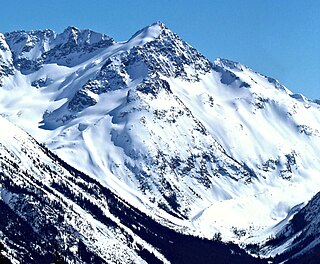
Mount Macbeth is a 2,639-metre (8,658-foot) glacier-clad peak located in the Garibaldi Ranges of the Coast Mountains, in Garibaldi Provincial Park of southwestern British Columbia, Canada. It is part of the Spearhead Range, which is a subset of the Garibaldi Ranges. It is situated 14 km (9 mi) southeast of Whistler, and 2 km (1 mi) south of Tremor Mountain, which is the highest point in the Spearhead Range. The Naden Glacier spreads out below the eastern aspect of the summit, the Macbeth Glacier lies below the south aspect, and the Curtain Glacier descends the northern slope. Precipitation runoff from the peak and meltwater from its glaciers drains into Fitzsimmons Creek which is a tributary of the Cheakamus River. Macbeth is most often climbed as part of the Spearhead Traverse. The first ascent of the mountain was made in 1969 by P. Starr, E. Bass, B. Ellis, and P. Macec via the northeast ridge. The peak was named in 1964 by an Alpine Club of Canada climbing party, to commemorate the 400th anniversary of William Shakespeare's birth. The mountain's name was officially adopted on August 27, 1965, by the Geographical Names Board of Canada.
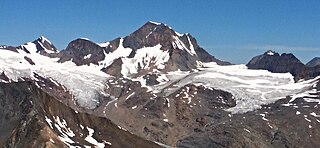
Eyebrow Peak is a prominent 3,362-metre (11,030-foot) glaciated mountain summit located in the Purcell Mountains in southeast British Columbia, Canada. It is the ninth-highest peak in the Purcells. It is situated 28 km (17 mi) south of The Bugaboos, 44 km (27 mi) west of Invermere, 6 km (3.7 mi) north of Mount Monica, and 18 km (11 mi) east of Duncan Lake. Its nearest higher peak is Commander Mountain, 11.4 km (7.1 mi) to the southeast. The first ascent of the mountain was made in 1914 by Edward Warren Harnden, D. Brown, L. Nettleton, and E. Parson via the west slopes. The name Eyebrow Peak came about by Arthur Oliver Wheeler in 1910 when viewing two broad rock scars near the summit, and their arrangement in connection with the surrounding snow created the appearance of enormous eyebrows. However, using the same sightings as Wheeler, Professor Peter Robinson showed that Wheeler actually saw Mount Farnham. Poor weather conditions led to Wheeler's error, and the Eyebrow moniker was then moved to its present location. The mountain's name was officially adopted June 9, 1960, by the Geographical Names Board of Canada.
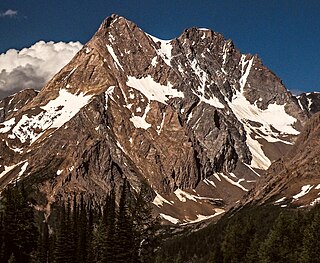
Jumbo Mountain, sometimes called Mount Jumbo, is a 3,437 meter elevation mountain summit located 42 km (26 mi) west-southwest of Invermere in the Purcell Mountains of southeast British Columbia, Canada. The nearest higher peak is Mount Farnham, 11 km (6.8 mi) to the north-northeast, and Karnak Mountain is set 0.79 km (0.49 mi) to the west. Jumbo and Karnak form a double summit massif which is the second-highest mountain in the Purcells, and fourth-highest in the Columbia Mountains. The first ascent of Jumbo Mountain was made August 4, 1915, by H.O. Frind, A.H. & E.L. MacCarthy, M & W.E. Stone, B. Shultz, and Conrad Kain via the North/Northeast Slopes. The peak was named by Edward Warren Harnden after the 1892 Jumbo Mineral Claim on nearby Toby Creek, which in turn was named for Jumbo the elephant. The mountain's toponym was officially adopted March 31, 1924, when approved by the Geographical Names Board of Canada.
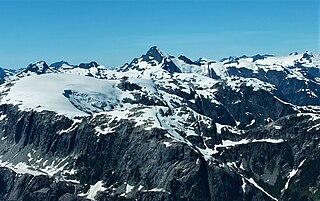
Mount Tinniswood is a 2,606-metre (8,550-foot) mountain summit located in British Columbia, Canada.

Grenelle Mountain is a 3,047-metre (9,997-foot) mountain summit located in British Columbia, Canada.

Bravo Peak is a 3,105-metre (10,187-foot) summit located in British Columbia, Canada.

Spearman Peak is a 3,365-metre (11,040-foot) summit located in British Columbia, Canada.
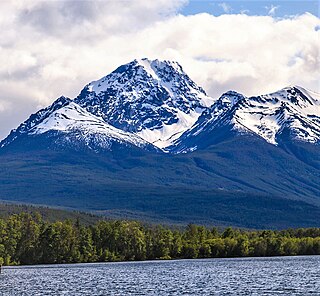
Whitesaddle Mountain is a summit located in British Columbia, Canada.
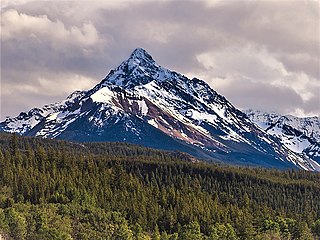
Blackhorn Mountain is a summit located in British Columbia, Canada.
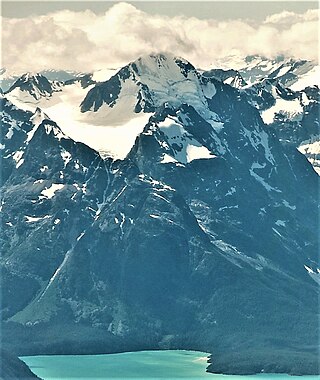
Mount Farrow is a mountain summit in British Columbia, Canada.
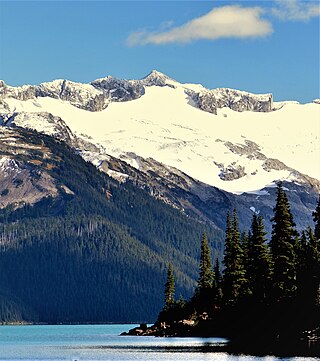
Mount Carr is a 2,590-metre (8,497-foot) mountain summit located in British Columbia, Canada.

Darling Peak is a 2,310-metre (7,580-foot) mountain summit located in British Columbia, Canada.





















